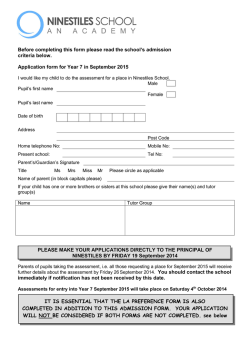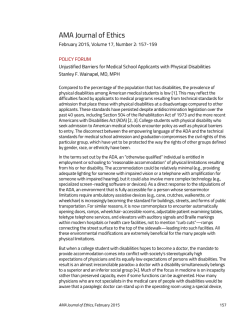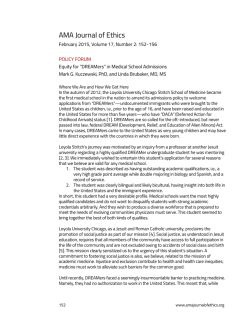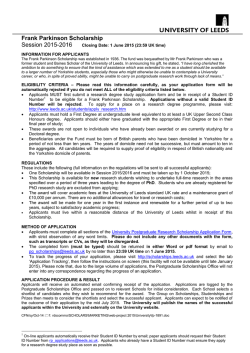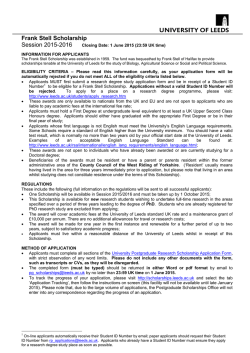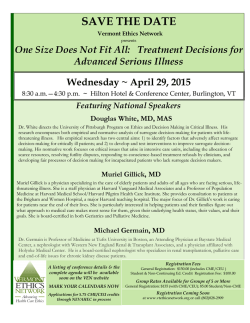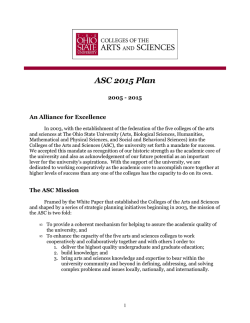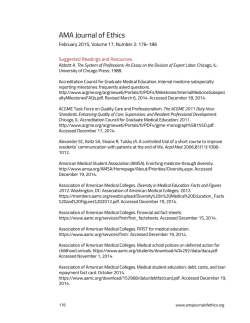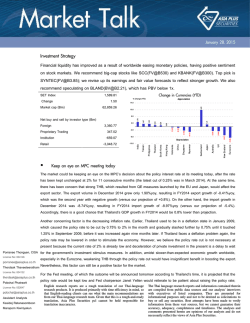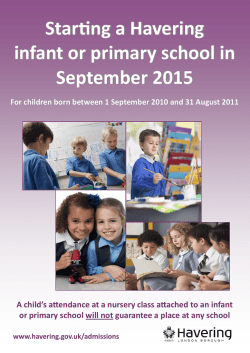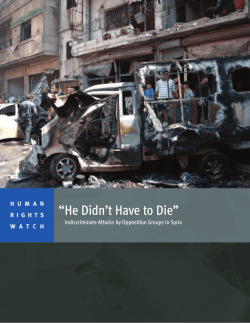
AMA Journal of Ethics - American Medical Association
AMA Journal of Ethics February 2015, Volume 17, Number 2: 172-175 SECOND THOUGHTS Promoting the Affordability of Medical Education to Groups Underrepresented in the Profession: The Other Side of the Equation Marc J. Kahn, MD, MBA, and Ernest J. Sneed, MD In spite of best efforts by the Association of American Medical Colleges (AAMC), the American Medical Association (AMA), and other national groups, entering medical students remain a relatively homogeneous group, with many backgrounds underrepresented. Although the combined percentage of people in the US from African American, Native American, and Hispanic backgrounds is 31 percent [1], only roughly 15 percent of current medical school applicants, 12 percent of medical school graduates [2], and 6 percent of practicing physicians [3] are from these ethnic backgrounds. Given that, by the year 2050, the racial and ethnic minority populations in the US are projected to comprise nearly half the population [4], this underrepresentation looks likely to grow if left unchecked. Having a diverse medical school class and physician workforce is important to the future of health care in the United States. Several studies have shown that students from underrepresented groups are more likely than whites to provide health care services in underserved communities. For example, a 2012 study of California physicians found that, regardless of specialty, African American, Latino, and Pacific Islander physicians were more likely to practice in underserved or health shortage areas than their white counterparts; in certain specialties, Asian physicians were also [5]. The AAMC reported that, among students entering medical school in 2011, 54.6 percent of African Americans, 36 percent of Hispanics, and 33.6 percent of American Indians or Alaska Natives had career plans to work in underserved areas, compared to 19.4 percent of Asians and 21.4 percent of whites [6]. Diversity also enriches the classroom experience. The ability to form relationships with those whose demographic attributes differ from one’s own is an essential skill, and diversity in the medical school class enhances this competency. Why have we failed to achieve a diverse medical workforce? Attending medical school in the US is a costly endeavor. US medical students graduate with a median debt of $180,000, and 43 percent of them have borrowed at least $200,000 [7]. Concerns over educational debt can have a strong influence on the decision to attend medical school. In the 2011 entering medical school class, 60.5 percent of African Americans, 45.7 percent of Hispanics, and 42.1 percent of American Indians or Alaska Natives already had debt. For approximately half of African Americans, Native Americans or Alaska Natives, and Latinos, that debt involved $25,000 or more in outstanding educational loans [6]. The majority of all matriculants planned to finance the bulk of medical school costs with loans [6]. Delayed earnings and high educational debt can be an intimidating hurdle, especially for firstgeneration college and first-generation medical school students. 172 www.amajournalofethics.org Secondly, the medical school admissions process favors applicants whose physician relatives and access to money afford prestigious experiences and shadowing opportunities. One in five medical students has a parent who is a physician [8]. The AAMC explains that the percentage of medical students from families in the highest quintile of household income has not dropped below 48 percent since 1987—half of students come from the richest 20 percent of the population—while the percentage of students from the lowest quintile has never risen above 5.5 percent [9]. Moreover, the percentage of entering medical students from families in the highest quintile of household income increased from 50.8 percent to 55.2 percent between 2000 and 2005 [9]. Given that members of marginalized groups are disproportionately likely not to be well-off and not to have had access to medical education in eras past, favoring these résumé boosters ultimately tips the scales toward the already privileged—in the US, generally the rich and white. Even expecting high academic achievement indirectly favors these applicants. Another significant contributor to the disincentive for students from underrepresented groups and lower-income families is the financial messaging to medical school applicants. The press, blogs, and even materials from the AAMC stress the high cost of a medical education. For example, the website of the FIRST for Medical Education Program, which provides information for students and families regarding financial aid, student debt, and money management [10], emphasizes the high cost of a medical education and warns about the cost of interviewing and applications [11]. There is even a subsection titled “Signs You Could Be Heading for Trouble” [12]. Unfortunately, there is little mention in the press of the other side of the financial equation, namely that entering the medical profession is a sound financial investment as well as a satisfying and personally rewarding career. In fact, it is estimated that a US medical degree has a “net present value”—the future value less the cost of acquiring it—of well over $1 million [13]. This high value means that a US medical degree is perhaps the most valuable degree in the world. What can be done? To maintain a physician workforce that is diverse both ethnically and socioeconomically, we need to stress the other side of the equation. Namely, we need to inform all students that, although going to medical school is expensive (the cost side), becoming a physician is a sound financial investment (the revenue side). We need to take advice from our colleagues in business and market our product. The “4 Ps” of marketing—product, price, promotion, and place—provide a good place to start. Our product is a career that is personally satisfying and allows for tremendous personal growth. We need to market the facts that money is available for the study of medicine and that borrowed money can be paid back on a physician’s salary, and we need to provide financial education explaining the role of debt, investment, and return. Creating financial literacy is critical to ensuring a diverse physician workforce. We need to make students aware of careers in medicine early in their educations, beginning in high school. This could be accomplished, for example, through summer programs that expose high school students to health care fields [14]. Programs that expose students to the disparities in the US health care system have been shown to increase applications to medical schools from students from minority backgrounds [15]. AMA Journal of Ethics, February 2015 173 We also need to be creative about developing talent among socioeconomically disadvantaged students. One method of doing so is employing programs that deemphasize typical academic milestones and coach students to develop knowledge and skills independently of their age or educational stage [16]. Lastly, we need to revise our admissions policies to prioritize creating a diverse medical school class, rather than selecting for achievements mostly open to the already privileged. Not every worthy applicant can afford to participate in international experiences or has a physician parent or grandparent who can arrange shadowing opportunities and other exposures to the medical field. Barriers to medical education can and will decrease the diversity the medical profession should have to care for our complex society. To care for the generations of the future, solid efforts should be directed at revising admissions standards, developing programs to expose high school students to careers in medicine, and improving the financial literacy of medical school applicants so that all applicants, regardless of socioeconomic or ethnic background, view medicine as a viable career option. References 1. US Census Bureau. USA QuickFacts. http://quickfacts.census.gov/qfd/ states/00000.html. Updated December 3, 2014. Accessed December 19, 2014. 2. Association of American Medical Colleges. US medical school applicants, 20072014: race/ethnicity self-identification counts with an applicant able to appear in more than one race/ethnicity category. October 21, 2014. https://www.aamc.org/ download/411642/data/10282014.pdf. Accessed December 19, 2014. 3. American Medical Student Association (AMSA). Enriching medicine through diversity. http://www.amsa.org/AMSA/Homepage/About/Priorities/Diversity.aspx. Accessed December 19, 2014. 4. Wade L. US racial/ethnic demographics: 1960, today, and 2050. Sociological Images. November 14, 2012. http://the societypages.org/socimages/2012/11/14/u-sracialethnic-demographics-1960-today-and-2050. Accessed December 19, 2014. 5. Walker KO, Moreno G, Grumbach K. The association among specialty, race, ethnicity, and practice location among California physicians in diverse specialties. J Natl Med Assoc. 2012;104(1-2):46-52. 6. Association of American Medical Colleges. Diversity in Medical Education: Facts and Figures 2012. Washington, DC: Association of American Medical Colleges; 2012. https://members.aamc.org/eweb/upload/Diversity%20in%20Medical%20Education _Facts%20and%20Figures%202012.pdf. Accessed December 19, 2014. 7. Association of American Medical Colleges. Medical student education: debt, costs, and loan repayment fact card. October 2014. https://www.aamc.org/download/ 152968/data/debtfactcard.pdf. Accessed December 19, 2014. 8. Hartocollis A. Getting into med school without hard sciences. New York Times. July 29, 2010. http://www.nytimes.com/2010/07/30/nyregion/30medschools.html? pagewanted=all&_r=0. Accessed December 19, 2014. 174 www.amajournalofethics.org 9. Jolly P. Diversity of US medical students by parental income. AAMC Analysis in Brief. 2008;8(1):1-2. https://www.aamc.org/download/102338/data/aibvol8no1.pdf. Accessed December 19, 2014. 10. Association of American Medical Colleges. FIRST for medical education. https://www.aamc.org/services/first/. Accessed December 19, 2014. 11. Association of American Medical Colleges. Financial aid fact sheets. https:// www.aamc.org/services/first/first_factsheets. Accessed December 15, 2014. 12. Association of American Medical Colleges. Taking control of credit card debt. https://www.aamc.org/services/first/first_factsheets/111916/taking_control_of _credit_card_debt.html. Accessed December 15, 2014. 13. Kahn MJ, Nelling EF. Estimating the value of medical education: a net present value approach. Teach Learn Med. 2010;22(3):205-208. 14. Crump C, Ned J, Winkleby MA. The Stanford Medical Youth Science Program: educational and science-related outcomes [published ahead of print August 6, 2014]. Adv Health Sci Educ Theory Pract. doi:10.1007/s10459-014-9540-6. 15. Rashied-Henry K, Fraser-White M, Roberts CB, et al. Engaging minority high school students as health disparity interns: findings and policy implications of a summer youth pipeline program. J Natl Med Assoc. 2012;104(9-10):412-419. 16. McGee R, Saran S, Krulwich TA. Diversity in the biomedical research workforce: developing talent. Mt Sinai J Med. 2012;79(3):397-411. Marc J. Kahn, MD, MBA, is the Peterman-Prosser Professor of Medicine at Tulane University School of Medicine in New Orleans, where he also serves as the senior associate dean for admissions and student affairs. Dr. Kahn’s research interests include medical education and financing the academic medical enterprise. Ernest J. Sneed, MD, is the assistant dean for student affairs at Tulane University School of Medicine in New Orleans. Dr. Sneed is interested in minority recruitment and retention. Related in AMA Journal of Ethics Equity for “DREAMers” in Medical School Admissions, February 2015 Unjustified Barriers for Medical School Applicants with Physical Disabilities, February 2015 Legacy Admissions in Medical School, December 2012 Bias in Assessment of Noncognitive Attributes, December 2012 Affirmative Action and Medical School Admissions, December 2012 The viewpoints expressed in this article are those of the author(s) and do not necessarily reflect the views and policies of the AMA. Copyright 2015 American Medical Association. All rights reserved. ISSN 2376-6980 AMA Journal of Ethics, February 2015 175
© Copyright 2025
